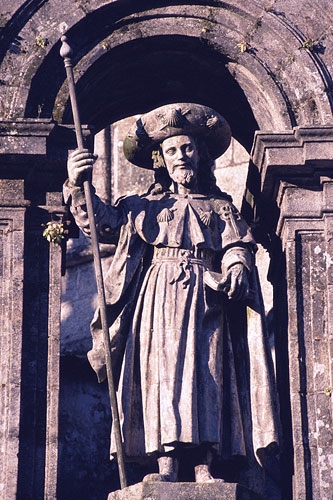As I am getting many questions about the gear I took for the journey, I prepared a short overview.
When you check how Saint James the Pilgrim is shown in various paintings and sculptures, it can give you a good idea about the means of a pilgrimage. He always wears a big hat. In contrast to his apostle buddies and other saints, who are usually shown barefoot, he wears long heel shoes. He holds a walking stick with a gourd for drinking. He is covered with a huge overcoat protecting him from the wind and rain.
There are several so called rules about backpacking and pilgrimages in general. Here I share my own observations and interpretations, without any claim that these are the golden rules for the middle way. Oscar Wilde once said that ‘Experience is merely the name men gave to their mistakes.’
- The heaviest item in every backpack is SHAME. The feeling of shame to ask for help, to rely on other peoples’ good will when it comes to basic life needs like food, water or accommodation (protection), to loose one’s control and comfort, it all comes with a heavy toll. So we rather over-pack, just to be ready for every situation, minimizing our exposure to weakness. I was never able to get fully rid of it, perhaps we are never able to. When you prepare the stuff before packing in into your backpack, try to evaluate the items you selected from that perspective. It might not be a happy exercise, but you do not go for that walk only for pleasure, right?
- The longest journey you go, the less stuff you need. This might sound like a paradox – life if full of paradoxes, so you better get used to them.
- You always pack your own personality, habits and yes, attachments. For example, I like to be independent and wanted to sleep out in the nature during my way, so I packed a small outdoor kitchen, a tent and all the things related to that. Those items had something to do with the shame-rule too, of course. Preparing and packing is a kind of exercise to getting to know yourself better.
- And finally a purely pragmatic one: the biggest backpack you take, the more useless stuff you pack into it. This rule points very well on some aspects of the human nature. What I did first during preparation, I bought and prepared everything I wanted to take and started to consider the backpack type then. Sounds wise? Perhaps not. What I did then, I estimated and measured the weight of each item as I wanted to squeeze the total weight down to 12-13 kg. I tired to follow a lightweight backpacking principle, saying that you shall take max 10% of your body weight on your back. I was that time 74 kg and there was no way to get down to 7,4 kg. Rule 1 and 3 start to apply instantly. So I arbitrary stated that I take a middle-size backpack of max 50 liters, with no more weight than 1,5. You can see that the gear wish-list decreased rapidly after that.
+ 1 . We do always over pack. Even though the packing and planning ritual took almost 6 months and I was very strict with each item, I did over-pack. Thanks to the grace of the Heavens though, I had the courage to throw away things on the way, but I had to wear the burden for a while before growing into that stage.
And now the list:
Backpack – Deuter 50+10, black (1,7). Kind of heavy one, there are more lightweight backpacks on the market, but I preferred a backpack with strong hip belts (hence the additional grammage). You see, I was never able to grow a sizable belly (yet)…
Shoes – it was the biggest and longest dilemma. Finally I took a Lowa Zephyr GTX. We became very close friends and when I passed the Alps and reached the Mediterranean Sea I sent them home. The delivery costed me some 30 euros but I did not want to leave them behind. Then in Montpelier I bought a Salmon Eskape GTX. They were the only available shoes in that outdoor shop but they did not disappoint during the second half of the walkabout. Also they hold me stable when crossing the Pyrenees. Still, when you plan to walk longer in the mountains I do recommend high heel boots.
Tent – Vaude Lizard (1kg). I cannot praise this tent enough! It stood still during some wild summer storms in the Alps with some help. However, it is not a tent for high altitudes.
Sleeping Bag – I had a Viking Warmpeace three-season bag from previous hikes. Very light, small and comfortable. Though, when the filling (duck down) gets even a little wet, the comfort temperature gets unpleasantly higher. I had some really hard times in late August in the French Alps and later in September, especially in the early morning hours. Next time I might take a synthetic one.
Sleeping Mattress Z Lite Therm-a-rest. It is ultralight, yes. I really like it in the first months, easy to fold and unfold, but as it got amortized during the heavy daily use, the comfort became very ‘Spartan’. So I bought a yet heavier, but cozy, inflatable mattress in Geneve. Yes, in Switzerland – you can imagine how desperate I was with the matter 🙂
I will prepare a separate post about clothing and the small stuff, like kitchen, navigation and hygienic. When it comes to the key items, I suggest to read Antti’s posts. I derived lots of inspiration from them!













































































































